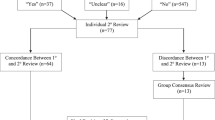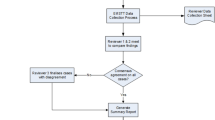Abstract
Objective
Determine the associations between neonatal intensive care unit (NICU) medication safety practices, laboratory-based adverse events (lab-AEs), and death.
Study design
We combined data from a 2016 survey of Pediatrix NICUs on use of medication safety practices with 2014–2016 infant data. We grouped NICUs based on the number of safety practices used (≤5, 6–7, and 8–10) and evaluated the association between the number of safety practices used and lab-AEs and deaths using logistic regressions.
Results
Of the 94 NICUs included, 17% used ≤5 medication safety practices, 51% used 6–7, and 32% used 8–10. NICUs with more safety practices did not have a difference in lab-AEs or death.
Conclusion
In this cohort, the use of more medication safety practices was not associated with fewer lab-AEs or decreased death.
This is a preview of subscription content, access via your institution
Access options
Subscribe to this journal
Receive 12 print issues and online access
$259.00 per year
only $21.58 per issue
Buy this article
- Purchase on Springer Link
- Instant access to full article PDF
Prices may be subject to local taxes which are calculated during checkout
Similar content being viewed by others
References
Classen DC, Pestotnik SL, Evans RS, Lloyd JF, Burke JP. Adverse drug events in hospitalized patients. Excess length of stay, extra costs, and attributable mortality. JAMA. 1997;277:301–6.
Batel Marques F, Penedones A, Mendes D, Alves C. A systematic review of observational studies evaluating costs of adverse drug reactions. Clinicoecon Outcomes Res. 2016;8:413–26.
Kunac DL, Kennedy J, Austin N, Reith D. Incidence, preventability, and impact of Adverse Drug Events (ADEs) and potential ADEs in hospitalized children in New Zealand: a prospective observational cohort study. Paediatr Drugs. 2009;11:153–60.
Moore TJ, Weiss SR, Kaplan S, Blaisdell CJ. Reported adverse drug events in infants and children under 2 years of age. Pediatrics. 2002;110:e53.
Kearns GL, Abdel-Rahman SM, Alander SW, Blowey DL, Leeder JS, Kauffman RE. Developmental pharmacology-drug disposition, action, and therapy in infants and children. N Engl J Med. 2003;349:1157–67.
Krzyzaniak N, Bajorek B. Medication safety in neonatal care: a review of medication errors among neonates. Ther Adv Drug Saf. 2016;7:102–19.
Stavroudis TA, Shore AD, Morlock L, Hicks RW, Bundy D, Miller MR. NICU medication errors: identifying a risk profile for medication errors in the neonatal intensive care unit. J Perinatol. 2010;30:459–68.
Chedoe I, Molendijk HA, Dittrich ST, Jansman FG, Harting JW, Brouwers JR, et al. Incidence and nature of medication errors in neonatal intensive care with strategies to improve safety: a review of the current literature. Drug Saf. 2007;30:503–13.
Suresh G, Horbar JD, Plsek P, Gray J, Edwards WH, Shiono PH, et al. Voluntary anonymous reporting of medical errors for neonatal intensive care. Pediatrics. 2004;113:1609–18.
Morriss FH. Adverse medical events in the NICU. Epidemiol Prev. 2008;9:e8–23.
Morriss FH Jr, Abramowitz PW, Nelson SP, Milavetz G, Michael SL, Gordon SN, et al. Effectiveness of a barcode medication administration system in reducing preventable adverse drug events in a neonatal intensive care unit: a prospective cohort study. J Pediatr. 2009;154:363–8, 368. e361.
Cordero L, Kuehn L, Kumar RR, Mekhjian HS. Impact of computerized physician order entry on clinical practice in a newborn intensive care unit. J Perinatol. 2004;24:88–93.
Morriss FH Jr, Abramowitz PW, Nelson SP, Milavetz G, Michael SL, Gordon SN. Risk of adverse drug events in neonates treated with opioids and the effect of a bar-code-assisted medication administration system. Am J Health Syst Pharm. 2011;68:57–62.
Nguyen MR, Mosel C, Grzeskowiak LE. Interventions to reduce medication errors in neonatal care: a systematic review. Ther Adv Drug Saf. 2018;9:123–55.
Greenberg RG, Smith PB, Bose C, Clark RH, Cotten CM, DeRienzo C. National survey of neonatal intensive care unit medication safety practices. Am J Perinatol. 2018;35:1419–22.
Matti N, Nguyen MR, Mosel C, Grzeskowiak LE. Utilization of neonatal medication error prevention strategies: a clinical practice survey of Australian and New Zealand neonatal units. Ther Adv Drug Saf. 2018;9:609–17.
Spitzer AR, Ellsbury DL, Handler D, Clark RH. The Pediatrix BabySteps Data Warehouse and the Pediatrix QualitySteps improvement project system-tools for “meaningful use” in continuous quality improvement. Clin Perinatol. 2010;37:49–70.
England A, Wade K, Smith PB, Berezny K, Laughon M. Best Pharmaceuticals for Children Act - Pediatric Trials Network Administrative Core C. Optimizing operational efficiencies in early phase trials: The Pediatric Trials Network experience. Contemp Clin Trials. 2016;47:376–82.
Laughon MM, Chantala K, Aliaga S, Herring AH, Hornik CP, Hughes R, et al. Diuretic exposure in premature infants from 1997 to 2011. Am J Perinatol. 2015;32:49–56.
Smith PB, Cotten CM, Hudak ML, Sullivan JE, Poindexter BB, Cohen-Wolkowiez M, et al. Rifampin pharmacokinetics and safety in preterm and term infants. Antimicrob Agents Chemother. 2019;63:e00284–19.
Hornik CP, Herring AH, Benjamin DK Jr, Capparelli EV, Kearns GL, van den Anker J, et al. Adverse events associated with meropenem versus imipenem/cilastatin therapy in a large retrospective cohort of hospitalized infants. Pediatr Infect Dis J. 2013;32:748–53.
Piper L, Smith PB, Hornik CP, Cheifetz IM, Barrett JS, Moorthy G, et al. Fluconazole loading dose pharmacokinetics and safety in infants. Pediatr Infect Dis J. 2011;30:375–8.
Sampson MR, Bloom BT, Lenfestey RW, Harper B, Kashuba AD, Anand R, et al. Population pharmacokinetics of intravenous acyclovir in preterm and term infants. Pediatr Infect Dis J. 2014;33:42–49.
Ericson JE, Arnold C, Cheeseman J, Cho J, Kaneko S, Wilson E, et al. Use and safety of erythromycin and metoclopramide in hospitalized infants. J Pediatr Gastroenterol Nutr. 2015;61:334–9.
Gonzalez D, Delmore P, Bloom BT, Cotten CM, Poindexter BB, McGowan E, et al. Clindamycin pharmacokinetics and safety in preterm and term infants. Antimicrob Agents Chemother. 2016;60:2888–94.
Ku LC, Zimmerman K, Benjamin DK, Clark RH, Hornik CP, Smith PB, et al. Safety of enalapril in infants admitted to the neonatal intensive care unit. Pediatr Cardiol. 2017;38:155–61.
Cohen-Wolkowiez M, Poindexter B, Bidegain M, Weitkamp JH, Schelonka RL, Randolph DA, et al. Safety and effectiveness of meropenem in infants with suspected or complicated intra-abdominal infections. Clin Infect Dis. 2012;55:1495–502.
Commander SJ, Gao J, Zinkhan EK, Heresi G, Courtney SE, Lavery AP, et al. Safety of metronidazole in late pre-term and term infants with complicated intra-abdominal infections. Pediatr Infect Dis J. 2020;39:e245–8.
Buckley MS, Rasmussen JR, Bikin DS, Richards EC, Berry AJ, Culver MA, et al. Trigger alerts associated with laboratory abnormalities on identifying potentially preventable adverse drug events in the intensive care unit and general ward. Ther Adv Drug Saf. 2018;9:207–17.
DiPoto JP, Buckley MS, Kane-Gill SL. Evaluation of an automated surveillance system using trigger alerts to prevent adverse drug events in the intensive care unit and general ward. Drug Saf. 2015;38:311–7.
Fabretti SC, Brassica SC, Cianciarullo MA, Romano-Lieber NS. Triggers for active surveillance of adverse drug events in newborns. Cad Saude Publica. 2018;34:e00069817.
Kane-Gill SL, Dasta JF, Schneider PJ, Cook CH. Monitoring abnormal laboratory values as antecedents to drug-induced injury. J Trauma. 2005;59:1457–62.
Du W, Lehr VT, Lieh-Lai M, Koo W, Ward RM, Rieder MJ, et al. An algorithm to detect adverse drug reactions in the neonatal intensive care unit. J Clin Pharm. 2013;53:87–95.
Cammack B, Oschman A, Lewis T. Improving Recognition and Reporting of Adverse Drug Reactions in the NICU: A Quality Improvement Project. Pediatr Qual Saf. 2019;4:e203.
Institute for Safe Medication Practices (ISMP). ISMP list of high-alert medications in acute care settings. https://www.ismp.org/tools/institutionalhighAlert.asp.
Pratico AD, Longo L, Mansueto S, Gozzo L, Barberi I, Tiralongo V, et al. Off-label use of drugs and adverse drug reactions in pediatric units: a prospective, multicenter study. Curr Drug Saf. 2018;13:200–7.
Hsieh EM, Hornik CP, Clark RH, Laughon MM, Benjamin DK Jr, Smith PB, et al. Medication use in the neonatal intensive care unit. Am J Perinatol. 2014;31:811–21.
Gore R, Chugh PK, Tripathi CD, Lhamo Y, Gautam S. Pediatric off-label and unlicensed drug use and its implications. Curr Clin Pharm. 2017;12:18–25.
Cuzzolin L, Atzei A, Fanos V. Off-label and unlicensed prescribing for newborns and children in different settings: a review of the literature and a consideration about drug safety. Expert Opin Drug Saf. 2006;5:703–18.
Holdsworth MT, Fichtl RE, Raisch DW, Hewryk A, Behta M, Mendez-Rico E, et al. Impact of computerized prescriber order entry on the incidence of adverse drug events in pediatric inpatients. Pediatrics. 2007;120:1058–66.
Manrique-Rodriguez S, Sanchez-Galindo AC, Lopez-Herce J, Calleja-Hernandez MA, Martinez-Martinez F, Iglesias-Peinado I, et al. Impact of implementing smart infusion pumps in a pediatric intensive care unit. Am J Health Syst Pharm. 2013;70:1897–906.
Upperman JS, Staley P, Friend K, Neches W, Kazimer D, Benes J, et al. The impact of hospitalwide computerized physician order entry on medical errors in a pediatric hospital. J Pediatr Surg. 2005;40:57–9.
Larsen GY, Parker HB, Cash J, O’Connell M, Grant MC. Standard drug concentrations and smart-pump technology reduce continuous-medication-infusion errors in pediatric patients. Pediatrics. 2005;116:e21–5.
Hardmeier A, Tsourounis C, Moore M, Abbott WE, Guglielmo BJ. Pediatric medication administration errors and workflow following implementation of a bar code medication administration system. J Health Qual. 2014;36:54–61. quiz 61-53.
Ferranti JM, Horvath MM, Jansen J, Schellenberger P, Brown T, DeRienzo CM, et al. Using a computerized provider order entry system to meet the unique prescribing needs of children: description of an advanced dosing model. BMC Med Inf Decis Mak. 2011;11:14.
Funding
This study was funded by grant #: NIH-5R21HD080606-02.
Author information
Authors and Affiliations
Contributions
All authors have been involved in the study design, analysis, and manuscript revision. All authors read and approved the final manuscript. LEM is the guarantor who accepts full responsibility for the work and the conduct of the study, had access to the data, and controlled the decision to publish. LEM contributed to the conception and design of the study, the data interpretation, the manuscript drafting, and the critical revision of the manuscript. CDR contributed to the conception and design of the study, and both supervised and contributed to the data acquisition and interpretation, manuscript drafting, and critical revision of the manuscript. PBS contributed to the conception and design of the study, the data interpretation, and the critical revision of the manuscript. CB contributed to the conception and design of the study, the data interpretation and the critical revision of the manuscript. RHC contributed to the conception and design of the study, the data acquisition, the data interpretation, and the critical revision of the manuscript. CMC contributed to the conception and design of the study, the data interpretation, and the critical revision of the manuscript. DKB contributed to the conception and design of the study, the data interpretation, and the critical revision of the manuscript. CDH contributed to the conception and design of the study, the data interpretation, and the critical revision of the manuscript. RGG had full access to all of the data in the study and takes responsibility for the integrity of the data and the accuracy of the data analysis. RGG contributed to the conception and design of the study, the data interpretation, the manuscript drafting, and the critical revision of the manuscript.
Corresponding author
Ethics declarations
Conflict of interest
RGG has received support from industry for research services (https://dcri.org/about-us/conflict-of-interest/).
Additional information
Publisher’s note Springer Nature remains neutral with regard to jurisdictional claims in published maps and institutional affiliations.
Rights and permissions
About this article
Cite this article
Miller, L.E., DeRienzo, C., Smith, P.B. et al. Association between neonatal intensive care unit medication safety practices, adverse events, and death. J Perinatol 41, 1739–1744 (2021). https://doi.org/10.1038/s41372-020-00857-y
Received:
Revised:
Accepted:
Published:
Issue Date:
DOI: https://doi.org/10.1038/s41372-020-00857-y



